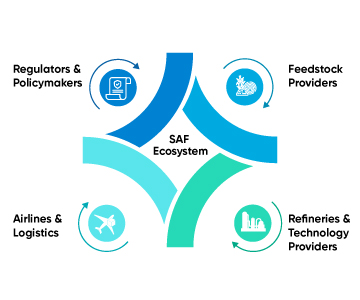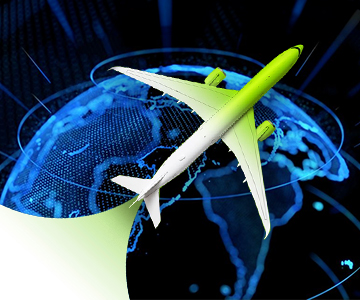
Sustainable Aviation Fuel (SAF) is an advanced biofuel that reduces carbon emissions by up to 80% compared to traditional jet fuel. Produced from renewable feedstocks, including agricultural residues, municipal waste, and non-food crops, SAF provides a practical and scalable solution for aviation sector decarbonisation.

Feedstock Providers – Agricultural and waste-based sources for SAF production
Refineries & Technology Providers – Conversion of feedstocks into SAF
Airlines & Logistics – Integration of SAF into commercial and cargo flights
Regulators & Policymakers – Setting industry standards and compliance frameworks
The global SAF market is expanding rapidly, with governments and industry stakeholders investing in research, production, and supply chain development.
EU & USA – Both regions enforce strong SAF blending mandates to decarbonize aviation. The EU’s ReFuelEU initiative and U.S. tax credits under the Inflation Reduction Act support SAF deployment.
Japan & China – These nations focus on waste-based and hydrogen-based SAF production. Japan promotes advanced biofuels, while China is expanding its renewable energy-driven SAF industry.
India – India is leveraging biomass and policy support to emerge as a key SAF producer. With abundant raw materials, the country has the potential to become a global leader in SAF production.
SAF: The Key to Net-Zero Aviation
CORSIA: A Global Market-Based Mechanism
Projected SAF Demand by 2050


India is the third-largest aviation market and has the potential to become a leader in SAF production. With strong agricultural and waste resources, combined with policy support, India can achieve large-scale SAF adoption.
SAF Blending Targets – India aims for 1% SAF blending by 2027, 2% by 2028, and 5% by 2030 to support aviation decarbonization.
National Bio-Energy Mission – The mission provides policy support for biofuels, including SAF, encouraging domestic production and technological advancements.
Airline Commitments – Indian carriers are exploring SAF adoption to meet carbon reduction targets and align with global sustainability goals.
Reduces lifecycle carbon emissions by up to 80% – SAF significantly cuts aviation-related emissions compared to conventional jet fuel, aiding in climate change mitigation.
Supports clean air initiatives by lowering aviation-related pollution – SAF contains fewer particulates and sulfur, reducing air pollution and improving urban air quality.
Helps prevent stubble burning by utilising agricultural residues – By converting crop waste into SAF, it provides an alternative to burning, reducing air pollution and soil degradation.
Contributes to a circular economy by converting waste into fuel – SAF promotes sustainability by repurposing waste materials and reducing dependence on fossil fuels.


Adopting SAF benefits businesses across multiple sectors.
Regulatory Compliance – Align with international emission reduction targets
Carbon Credits & Offsetting – Generate high-quality Scope 3 emission reductions
Brand Leadership – Strengthen sustainability commitments and ESG credentials
Operational Efficiency – Reduce long-term fuel costs through SAF integration

Revolutionizing the future of aviation with sustainable innovation where cleaner skies, efficient technology, and eco-friendly solutions come together to shape a greener tomorrow.